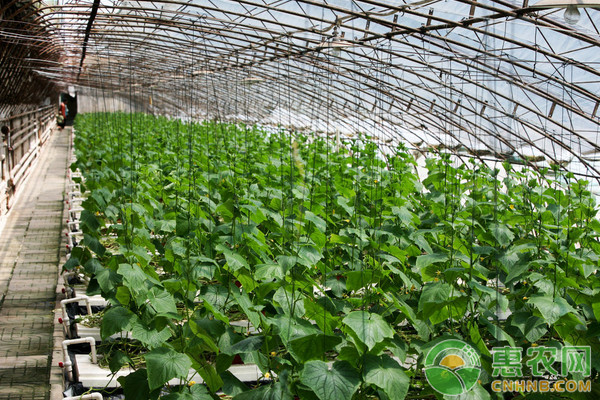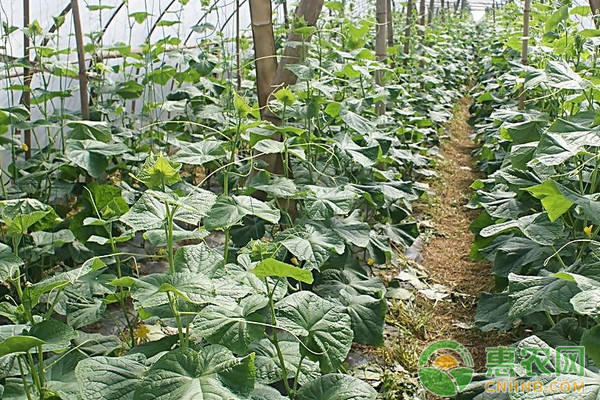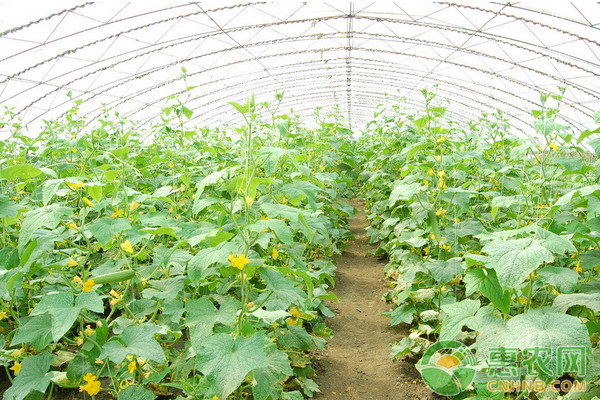Causes and prevention measures of premature aging of cucumber in winter shed
There are many reasons for the premature aging of cucumber in winter sheds, which can be avoided by strengthening the management in the middle and late stages. Therefore, according to the reasons of premature aging, strengthening spring management and taking effective measures early is the key to preventing premature aging of cucumber, improving cucumber yield in winter shed, improving cucumber quality and increasing production efficiency. First, the cause of premature aging of cucumber in winter shed Root aging As the growth time increases, the roots of the cucumbers age; the temperature in the spring increases, and improper watering can damage the roots. The root system is the only channel for cucumber to absorb water and nutrients. The roots absorb more water and nutrients, and the roots absorb less water and nutrients. The optimum temperature for cucumber root growth is 20 to 23 ° C. Roots are more susceptible to injury than 25 ° C. If the cold water is poured after the soil temperature is high after noon, the temperature of the soil differs greatly from the temperature of the irrigation water, which easily damages the root system, causing the water and nutrient supply to be blocked. If the roots are aging or injured, the absorption capacity of the plants will decrease, and the dead leaves and aging leaves will increase, which is the main cause of premature aging of cucumber in winter sheds. 2. Improper fertilizer and water Some vegetable farmers blindly apply a large amount of chemical fertilizers, causing the concentration of soil solution to be too high, causing damage to the roots, and the root tip becomes rust or local necrosis, which weakens the absorption capacity of the roots and affects the normal growth of the plants. Some vegetable farmers believe that they are about to pull up. So, reduce the number of watering and fertilization, resulting in insufficient fertilizer: these will cause premature aging of cucumber. 3. The shed temperature is too high The optimum temperature for growth of cucumber plants is 25-30 °C. As the temperature in spring increases, the temperature in the greenhouse is often too high. When the temperature exceeds 35 °C, heat damage will occur, causing burns on cucumber stems and leaves, and white spots appear. Severe leaves are dry, photosynthesis is affected, organic nutrients are reduced, and plants grow poorly. 4. Increased pests and diseases As the growth time of cucumber increased, the bacteria and eggs in the shed continued to increase. In the middle and late stages of cucumber growth, powdery mildew, anthracnose, downy mildew, bacterial angular spot, and blight were more serious. As the temperature rises, the open time of the greenhouse vents increases, and pests such as external mites and Liriomyza sinensis also enter the shed. The pests and diseases caused the cucumber stems and leaves to be aggravated, the pests and leaves increased, the photosynthesis of the leaves decreased, the stems and leaves were withered early, and the deformed melons and diseased melons often appeared. 5. Overdose Most vegetable farmers only pay attention to chemical control, but ignore agricultural measures, the application interval is short, the concentration is seriously exceeded, causing excessive application of pesticides, forming phytotoxicity, plant leaves become wrinkled, photosynthesis declines; some vegetable farmers also apply hormones Pesticide-like pesticides cause phytotoxicity in cucumber plants, and the loss of green leaf function leads to an increase in premature aging. 6. Management relaxation In the late growth stage of cucumber, the yield decreased, the price decreased, the benefit was reduced, and the management of vegetable farmers was relaxed. This is especially true for the vines that have more labor, not the vines that have reached the top yet, or the vines are too large. When the vines are not falling, the lower leaves are aging, which not only cannot produce nutrients, but also consume nutrients; when the vines are too large, the number of leaves remaining on the plants is too small, the function of producing photosynthetic products is reduced, and the formed organic nutrients cannot be satisfied. The demand for normal growth and development of cucumbers often causes the melon to grow weak and the melons are deformed. Second, the prevention of premature aging of cucumber in winter shed Rooting root In the management of cucumber, the temperature in the shed should not exceed 25 °C, in order to maintain the root system and promote root growth; in the watering time, it should be carried out before 10:00 am, be careful not to water in the afternoon, in case the ground temperature is too high, If the water temperature is too low, it will cause damage to the root system; for the greenhouse with soil compaction, the mulch film can be removed, the ploughing can be carried out, the soil permeability can be enhanced, and the deep rooting and normal growth of the roots can be promoted. 2. Strengthening fertilizer and water management In the late growth stage of cucumber, according to the growth trend, combined with watering per acre, high-nitrogen high-potassium ternary compound fertilizer (15 - 5 - 20) 7.5 ~ 10 kg per acre, the dosage should not be too much to prevent root burning. It is usually applied once every 15 to 20 days to promote the growth of plants and fruits. For cucumber greenhouses where roots have been senescent in the later stages, foliar fertilizers such as 0.2% to 0.3% potassium dihydrogen phosphate + humic acid foliar fertilizer can be added and sprayed every 7 to 10 days to compensate for the lack of root absorption. To delay the aging process of plants. 3. Prevent high temperature heat damage 1 release the wind and cool down. When the temperature in the shed exceeds 30 °C, the air should be cooled down. In the afternoon, the temperature should be increased. If the temperature in the shed is still high after the top air is released, some or all of the bottom wind can be released according to the temperature. 2 irrigation and cooling. It can be combined with weather conditions and soil moisture to carry out irrigation and cooling. The irrigation and cooling should be carried out in advance, and the small water irrigation method should be adopted to prevent the damage of stems and leaves. 3 cover the shade net. If the above measures are not ideal, the sunshade net can be covered in time. Generally, the shade temperature can be reduced by about 5 °C after covering the shade net. However, it should be noted that this method can only be used under high temperature and strong light. When the afternoon light is weakened or the cloudy light is weak, the sunshade net should be pulled up in time. 4. Prevention of pests and diseases 1 disease. The main diseases in the middle and late growth of cucumber are: powdery mildew, anthracnose, downy mildew, bacterial angular spot, and blight. Powdery mildew can be treated with 10% difenoconazole water dispersion granules 1500 times solution, or 25% azoxystrobin suspension 1500 ~ 2000 times solution, or 12.5% ​​oxazolol emulsifiable concentrate 2500 times solution; % azoxystrobin suspension 1500 ~ 2000 times liquid, or 10% difenoconazole water dispersible granules 1500 times liquid and other chemicals control; downy mildew can use 72.2% frost mold water agent 600 ~ 800 times liquid, or 25 % azoxystrobin suspension 1500 ~ 2000 times liquid and other chemical control; bacterial keratosis can be used 72% agricultural streptomycin soluble powder 3000 ~ 4000 times solution, or 3% carbendazim wettable powder 600 ~ 800 times solution And other chemical control; blight can not only harm the leaves, but also damage the stems, can use 25% prochloraz oil 800 ~ 1000 times liquid, or 40% flusilazole emulsifiable oil 4000 times, or 70% thiophanate The spray control of wet powder and other drugs is better combined with the effect of root irrigation. 2 pests. There are mainly aphids, Liriomyza sativae, and the like. Aphids can be controlled with 10% imidacloprid WP 1500 times, or 3% acetamiprid emulsifiable concentrate 2000 times, or 10% nitenpyram water 4000 times solution; 50% chlorpyrifos can be used for larvae Powder 2000 ~ 3000 times liquid, or 1.8% avermectin EC 2000 ~ 3000 times liquid, or 25% thiamethoxam water dispersion granules 3000 ~ 5000 times liquid and other chemicals control. 5. Rational use of drugs For the prevention and treatment of diseases, we must adhere to the principle of "prevention and prevention". When pests occur in plants, the initial control should be mastered. The concentration of pesticides should be strictly controlled. Do not increase the dosage. Do not mix 3 to 5 pesticides to avoid damage to stems and leaves and slow down the winter shed. The process of premature aging of cucumber. 6. Strengthen management 1 Strengthen plant adjustment. During the growth of cucumber, pay attention to adjust the height of the plant in time. When the height of the stem is close to the top of the roof or exceed the operating height of the technician, it will fall. When the cucumber is falling, it cannot fall too low at one time. Too low is not conducive to the normal growth of cucumber. After the vines, the cucumber plants are maintained at about 1.5 meters high, ensuring more than 20 functional leaves on the plants, and it is necessary to grasp the even distribution of the leaves, maintain a reasonable lighting position, maintain the optimal leaf area coefficient, and improve the photosynthetic efficiency. It is best not to water for 7 days before falling, in order to reduce the water content of the stem tissue, enhance flexibility, and reduce the chance of pathogens invading from the wound. 2 Remove the pests and leaves of melons. For the emergence of dead leaves, aging leaves, diseased leaves and diseased worms, deformed melons should be removed in time to reduce nutrient consumption, promote nutrient concentration to normal fruit supply, control the spread and spread of pests and diseases, promote ventilation and light transmission and plants Growing. Cucumber cultivation in winter sheds is generally planted in late September, so you can collect this article in advance to prepare for the prevention of premature aging of winter shed cucumbers!
China Food flavoring Suppliers
Here you can find the related products in Food flavoring, we are professional manufacturer of Food flavoring Raw Material. We focused on international export product development, production and sales. We have improved quality control processes of Food flavoring to ensure each export qualified product.
If you want to know more about the products in Food flavoring, please click the Product details to view specification, application, pictures, prices and Other information about Food flavoring.
Whatever you are a group or individual, we will do our best to provide you with accurate and comprehensive message about Food flavoring!
Tartaric Acid, Vanillin, Menthol, Menthol Crystal, Flavoring agent, Baking powder Xi'an Gawen Biotechnology Co., Ltd , https://www.ahualynbios.com


